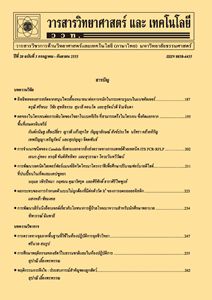Evaluation of Carbamate Pesticide Residues in Melons
Main Article Content
Abstract
This study aimed to determine the contamination of carbamate pesticides in Japanese melons, and to investigate health risk assessment from Japanese melons consumption. A total of 9 Japanese melons from 3 melon farms in Phitsanulok was collected and tested for 11 carbamate pesticide residues using QuEChERS (quick, easy cheap, effective rugged and safe) technique with HPLC-QTOF-MS (high performance liquid chromatography coupled with quadrupole time-of-flight mass spectrometry). The highest detected carbamate pesticide residue in Japanese melon samples was carbaryl (0.574±0.020 mg/kg), followed by aldicarb sulfoxide (0.310±0.622 mg/kg). Carbamate residues detected in Japanese melons did not exceed the standard of agricultural products of Thailand. The hazard quotient (HQ) of carbamate pesticides had a range of acceptable risk in which the highest HQ was aldicarb sulfoxide (HQ = 0.268), and the lowest HQ was methomyl (HQ = 0.007). Therefore, relevant agencies should monitor and determine other pesticide residues in Japanese melons for food safety.
Article Details
References
[2] National Bureau of Agricultural Commodity and Food Standards, 2017, Agricultural Product Standards MELON, Ministry of Agriculture and Cooperatives, Bangkok, 19 p. (in Thai)
[3] Weeplien, T., 2011, Effect of Plant Nutrients and Soil Moisture on Growth and Quality of 4 Melon Cultivars (Cucumis melo L.). Master Thesis, Kasetsart University, Bangkok, 95 p. (in Thai)
[4] Department of Agricultural Extension, 2017, Plant Production Report (r.t.01) Yearly Report 2017/2018, Available Source: http://production.doae.go.th/report/report_main2.php?report_type=1, 15 June 2018 (in Thai)
[5] Tira-umphon, A., and Ketudat-Cairns, M., 2015, Genetic Variation and Morpho logical Traits in Melon and Pickling Melon from ISSR, Research Report, Suranaree University of Technology, Nakon Ratchsima, 74 p. (in Thai)
[6] Guaman, V., 2009, Monitoring and Pest Control of Fruit Flies in Thailand: New Knowledge for Integrated Pest Management, p. 42, Examensarbete, Institutionen for Ekologi, Uppsala.
[7] Wanwimolruk, S., Kanchanamayoon, O., Boonpangrak, S. and Prachayasittikul, V., 2015, Food safety in Thailand 1: It is safe to eat watermelon and durian in Thailand, Environ. Health Prev. Med. 20: 204-215.
[8] Matthews, G.A., 2016, Pesticides: Health, Safety and the Environment, 2nd Ed., John Wiley & Sons, Inc., Hoboken, 266 p.
[9] Shalaby, M., Zorba, H. and Ziada, R., 2010, Reproductive toxicity of methomyl insecticide in male rats and protective effect of folic acid, Food Chem. Toxicol. 48: 3221-3226.
[10] Ozden, S., Catalgol, B., Gezginci-Oktayoglu, S., Arda-Pirincci, P., Bolkent, S. and Alpertunga, B., 2009, Methiocarb-induced oxidative damage following subacute exposure and the protective effects of vitamin E and taurine in rats, Food Chem. Toxicol. 47: 1676-1684.
[11] Chaiyanboon, P., 2015, Expansion the Efficiency of Pesticide Multi-Residue Analysis to the International Standard, Research Project Report, Department of Agriculture, Bangkok, 74 p. (in Thai)
[12] Ngamdokmai, N., Waranuch, N., Chootip, K., Nuengchamnong, N. and Ingkaninan, K., 2017, HPLC-QTOF-MS method for quantitative determination of active compounds in an anti-cellulite herbal compress, Songkhlanakharin J. Sci. Tech. 39: 463-470.
[13] Ratpukdi, S., Srihanaj, W. and Siriwong, W., 2015, Profenofos pesticide residue in chili from Huaruea district, Ubon Ratchathani and consumption risk, UBU Eng. J. 8(1): 115-122. (in Thai)
[14] Environmental Protection Agency, 1989, Risk Assessment: Guidance for Superfund Volume I Human Health Manual (Part A), Available Source: https://www.epa.gov/sites/production/files/2015-09/document s/rags_a.pdf, June 15, 2018.
[15] National Bureau of Agricultural Commodity and Food Standards, 2016, Agricultural product standards MKS.9002-2559 Pesticide Residues: Maximum Residues, Agricultural Commodity and Food Standards Notify, Ministry of Agriculture and Cooperatives, Bangkok, 61 p. (in Thai)
[16] World Health Organization, 2009, The WHO Recommended Classification of Pesticides by Hazard and Guidelines to Classification 2009, Available Source: http://www.who.int/ipcs/publications/pesticides_hazard_2009.pdf, July 11, 2018.
[17] Codex International Food Standards, 2018, Pesticide Databases, Available Source: http://www.fao.org/fao-who-codexalimentarius/codex-texts/dbs/pestres/pesticides/en, June 29, 2018.
[18] International Programme on Chemical Safety, Environmental Health Criteria 64 Carbamate Pesticides: A General Intro duction, Available Source: http://www.inchem.org/documents/ehc/ehc/ehc64.htm, July 14, 2018.
[19] Kamrin, M., 1997, Pesticide Profiles: Toxicity, Environmental Impact and Fate, Boca Raton, Lewis Publishers, Florida, 704 p.
[20] Health System Research Institute, 2016, The 5th Surveys of Human Health by Physical Examination 2014, Aksorn Graphic and Design Publishing, Ltd., Bangkok, 277 p. (in Thai)
[21] Thai Health Promotion Foundation, 2018, Snack: Eat well, be Useful, Available Source: http://resource.thaihealth.or.th/media/knowledge/16907, June 29, 2018. (in Thai)
[22] Klaimala, P., Sujiratham, W. and Jantib, P., 2010, Risk Assessment of Pesticides Used in Chilli Growing Plot on Aquatic Animals, Aquatic Plants, Soil, Water, and Sediment, Research Report of Fiscal Year 2010, Volume 2, Agricultural Production Science Research and Development Office, Bangkok, 179-187 p. (in Thai)
[23] U.S. Environmental Protection Agency Office of Pesticide Programs, 2000, Available Information on Assessing Exposure to Pesticides in Food-a User's Guide, Available Source: https://www.regulations.gov/document?D=EPA-HQ-OPP-2007-0780-0001, June 29, 2018.
[24] European Commission, 2018, EU-Pesticides Database, Available Source: http://ec.europa.eu/food/plant/pesticides, June 29, 2018.
[25] Plodpai, P. Poralokanon, P. and Athinuwat, D., 2015, Efficiency of bioformulation to Phyllotreta sinuate and Spodoptera litura controls on Chinese kale production system, Thai Sci. Technol. J. 23(6): 914-923. (in Thai)


